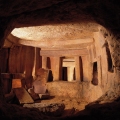Among the culinary traditions associated with Holy Week in Spain, potaje de vigilia—a humble stew of chickpeas and salted cod—stands out for its enduring presence and cultural resonance. Served across the country in homes, monasteries, charitable kitchens, and restaurants, this dish has been a staple of Good Friday meals for centuries, offering a flavorful reflection of a season historically marked by dietary restriction.
Chickpeas: A Cornerstone of Iberian Cuisine
Chickpeas (Cicer arietinum) are one of the earliest cultivated legumes, with archaeological evidence tracing their origins to the Fertile Crescent. Their arrival on the Iberian Peninsula is often attributed to Carthaginian agricultural practices, predating Roman influence. Over time, the crop adapted well to the arid interior of the peninsula, where it became a dietary mainstay among rural and urban populations alike.
The legume’s role in Spanish gastronomy is well documented. The French author Alexandre Dumas, traveling through Spain in the 19th century, famously remarked on the chickpea’s resilience in the pot: “a legume like the pea, as hard as a musket ball despite long cooking.” British traveler Richard Ford, in his Handbook for Travellers in Spain (1844), also observed its omnipresence. Spanish authors from Benito Pérez Galdós to Pedro García Cabrera have used the chickpea in metaphor and verse to evoke themes of survival, poverty, and sustenance.
Medieval Roots and Monastic Craft
The potaje’s history is rooted in medieval subsistence and monastic discipline. Chickpeas were prized for their nutritional density, versatility, and shelf life—qualities essential in a pre-industrial, agriculturally based society. In Al-Andalus, the cultivation and culinary use of chickpeas flourished, often in combination with vegetables, spices, and sometimes preserved fish. By the late Middle Ages, variations of legume-based stews had become widespread.
Two regions have historically stood out for their chickpea stews: Zamora, celebrated in the 17th century by writer Francisco de Quevedo, and Valencia del Ventoso in Badajoz, which today seeks Protected Geographical Indication status from the European Union.
The monastic context proved central to the dish’s evolution. Spanish convents, bound by rhythms of liturgical life, developed a culinary philosophy characterized by restraint, utility, and consistency. Within these cloistered kitchens, recipes like potaje de vigilia were codified through ritual precision: lengthy soaking of the chickpeas, careful desalting of the cod, and deliberate layering of flavor through a base of onions, garlic, and paprika. Leafy greens—typically spinach or Swiss chard—were added at the end to balance the dish’s density.
Cod: A Northern Traveler in Southern Kitchens
Salted cod became the defining ingredient of potaje de vigilia through a confluence of trade, geography, and regulation. During the medieval period, Christian fasting norms prohibited the consumption of meat during Lent and other penitential seasons, but allowed for fish. Salt cod—durable, portable, and inexpensive—emerged as a practical solution for inland communities far from the sea.
By the 15th century, cod from the North Atlantic was reaching Iberian markets via expanding trade networks. Its adoption was especially prominent in central Spain, where it was combined with local legumes to form an enduring staple. Salt cod became, paradoxically, the fish of the interior.
Convents as Culinary Archives
Monastic kitchens were not merely functional—they were cultural repositories. Religious communities across Spain, especially among Franciscan, Benedictine, and Carmelite orders, developed distinct culinary practices shaped by local traditions and interfaith influences. These kitchens refined the techniques and proportions of dishes like potaje de vigilia, preserving them through handwritten recipe books often guarded within monastic archives.
Cooking in the convent was both a necessity and a disciplined act. Recipes were transmitted with the care of liturgical texts, and cooking itself was seen as a form of communal service. Monasteries often extended hospitality to travelers, pilgrims, and the poor, particularly during feast days and periods of public observance. Through this interface with the broader society, monastic recipes entered civilian kitchens.
In many convents, the sale of prepared food—guisos, sweets, and preserves—became a source of income and a means of cultural preservation. The act of preparing potaje de vigilia, therefore, extended beyond nourishment. It became part of a broader tradition of seasonal labor, social care, and culinary memory.
A Legacy Sustained
Today, potaje de vigilia remains a culinary emblem of Spanish Holy Week, embodying the values of resourcefulness, patience, and communal heritage. While its origins lie in a particular religious calendar, the dish has long since transcended its liturgical function. It continues to appear each spring in both secular and sacred spaces—testament to the enduring legacy of monastic cooking and the deep roots of legumes in the Iberian palate.





